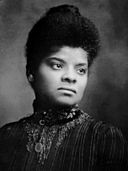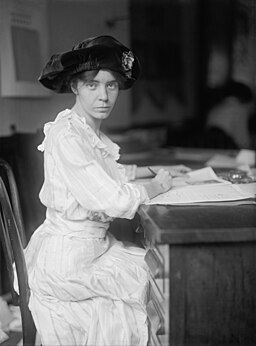10 Things To Know About the Suffs
If you ever have the chance to see Suffs, a Tony award winning musical detailing the experiences of women agitating for suffrage during the Wilson administration of 1912-1920, gather your best girls, pin on your suffragist ribbons, and experience the magic together.
While Suffs unfortunately closed on Broadway starting January 5, the show will fortunately go on a national US tour starting in Fall 2025. If seeing the show live is not in your wherewithal, it will also be featured by Great Performances on PBS and is streaming now as a cast recording via Spotify and Apple Music.
Created by Shaina Taub, the story follows the arc of Carrie Chapman Catt and Mary Church Terrell as the staid, institutional faces of a 60 year suffrage mission. Alice Paul and Ida B. Wells show up as upstarts, shaking up the status quo, demanding more decisive action. The play explores the internal fissures and fractures of the movement along the lines of age, race, and class with these four characters standing in as archetypes.
As the women wrestle along, they confront questions like who gets to be involved in the movement? How does a suffragist present herself? What does she stand for? What is she willing to do? What is the movement asking for? Can their efforts ever possibly by enough? Did they do the right thing?
No one is free from self-doubt or moments of startling realization, all leading toward a final stirring call for us in the now to continue the work (covered beautifully by Alex Newell and Broadway Inspirational Voices):
“I won’t live to see the future that I fight for
Maybe no one gets to reach that perfect day
If the work is never over
Then how do you keep marching anyway?
Do you carry your banner as far as you can?
Rewriting the world with your imperfect pen?
‘Til the next stubborn girl picks it up in a picket line over and over again?
And you join in the chorus of centuries chanting to her
The path will be twisted and risky and slow
But keep marching, keep marching
Will you fail or prevail? Well, you may never know
But keep marching, keep marching
‘Cause your ancestors are all the proof you need
That progress is possible, not guaranteed
It will only be made if we keep marching, keep marching on”
The experience of this show, the moments where I laughed and cried and felt so seen reminded me of the Ordain Woman movement, which bravely asked the biggest ask there could be for Mormon women, right at the doors of the building, upsetting the status quo, risking the eternal damnation of excommunication (is that better or worse than the torture of force feeding?). In President Wilson’s many evasions, I heard the echoes of all the arguments against equity in our own church. In the power of Ida B. Well’s resounding rebuke at the suggestion of a segregated protest march, I saw all the continuing pressure points of race and gender our Mormon feminist movement navigates. One character even hesitates to be married because she knows it will result in the end of her own legal personhood, echoing my own internal unease at the fine print of marriage in general and temple sealing ceremonies in specific.
With catchy songs, poignant moments, and fully weighted arcs, I hope to see this musical again and again and I would love to know what you thought if you’ve have the experience of seeing the show.
In the meantime, courtesy of my current hyper focus, here’s 10 Things to Know About the (historical) Suffs:
It’s suffragist, not suffragette. While the media coined the term suffragette, the suffragists found it demeaning. Inez Millholland, labor lawyer, led the procession of 8000 suffrage marchers in the first ever protest march down Pennsylvania Avenue. She was chosen to highlight the femininity, youth, and respectability of the marchers. The famed and influential Howard University sorority Delta Sigma Theta participated in the protest march. So did Helen Keller, though she left early when the crowds began to threaten the marchers.While the march was largely integrated, tensions rose in the Illinois delegation and among southern participants the day of. The Illinois delegation leader attempted to oust Ida B. Wells, but was unsuccessful. Mary Church Terrell’s National Association of Colored Women delegation was also threatened by a southern boycott and a participating group of men offered to act as a buffer. The Silent Sentinels stood in protest outside the White House for a peaceful six months before police threatened to arrest them, largely in response to Sentinel banners targeting a Russian delegation visiting the White House. The Russian revolution had resulted in women’s suffrage and the Sentinels wanted the Russian delegation to pressure the US to do the same as part of their wartime partnership.
The Silent Sentinels stood in protest outside the White House for a peaceful six months before police threatened to arrest them, largely in response to Sentinel banners targeting a Russian delegation visiting the White House. The Russian revolution had resulted in women’s suffrage and the Sentinels wanted the Russian delegation to pressure the US to do the same as part of their wartime partnership.  At least two dozen Sentinels were sent to Occoquan Workhouse following arrest during picketing. They survived deplorable conditions, physical violence, and learned how the workhouse system trapped Black women in forced labor. In all, about 218 women from 26 states were arrested during the protests. Alice Paul would suffer all her life from the effects of the force feeding she endured in both British and American jails in the pursuit of suffrage.
At least two dozen Sentinels were sent to Occoquan Workhouse following arrest during picketing. They survived deplorable conditions, physical violence, and learned how the workhouse system trapped Black women in forced labor. In all, about 218 women from 26 states were arrested during the protests. Alice Paul would suffer all her life from the effects of the force feeding she endured in both British and American jails in the pursuit of suffrage.  Woodrow Wilson referred to his first and second wife as “little girl.” His ick is legion. From 1912 to 1918, Wilson largely ignored the suffrage movement until it became clear that women’s suffrage would help improve the democratic reputation of the US on the global stage while he tried to sell the League of Nations. His personal views never changed (“universal suffrage is at the foundation of every evil in this country”), but he was willing to put his support behind the amendment for the political gain. The deciding vote in Tennessee that finally ratified the 19th Amendment in 1920 voted aye because his mother asked him to.
Woodrow Wilson referred to his first and second wife as “little girl.” His ick is legion. From 1912 to 1918, Wilson largely ignored the suffrage movement until it became clear that women’s suffrage would help improve the democratic reputation of the US on the global stage while he tried to sell the League of Nations. His personal views never changed (“universal suffrage is at the foundation of every evil in this country”), but he was willing to put his support behind the amendment for the political gain. The deciding vote in Tennessee that finally ratified the 19th Amendment in 1920 voted aye because his mother asked him to. Facts from Mr. President, How Long Must We Wait? Alice Paul, Woodrow Wilson, and the Fight for the Right to Vote by Tina Cassidy and Jailed for Freedom: American Women Win the Vote by suffragist Doris Stevens.
Photos are public domain from Wikimedia Commons.



